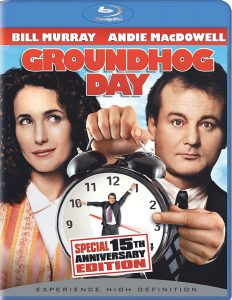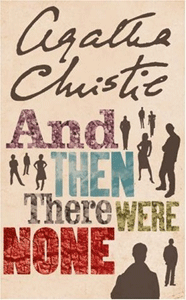“And Then There Were None” (1939) is a widely acknowledged classic, often noted as being one of Agatha Christie’s elite puzzles. Indeed, it is that – and it’s a fascinating study of 10 characters, plus a great atmospheric piece, as Christie moors these folks on a small island a mile off the Devon coast in stormy weather.
Proto-slasher?
But “And Then There Were None” (also titled “Ten Little Indians,” and originally published in the U.K. with an even more offensive title to American ears) isn’t mentioned often enough as a great slasher novel. Although the term “slasher” came about in the 1970s in regard to movies (with “Halloween” labeled as the trope codifier), it has since been applied to all media.
Despite the term, slashers have never required that all the kills be via knife slashings. Indeed, Season 4 of TV’s “Slasher” features a variety of kills and it is certainly influenced by “And Then There Were None.” The killer aims to punish his or her victims for past moral crimes, luring them to an island from which there is no easy egress, and where everyone will suspect everyone else.

“And Then There Were None” (1939)
Also published as: “Ten Little Indians”
Author: Agatha Christie
Genre: Mystery
Setting: Indian Island, off the coast of Devon, England, 1939
Perhaps the biggest case against “ATTWN” being a slasher is that we usually don’t see the murder itself; we just see the corpse. In a slasher, we usually see the killing (with the killer being masked when it’s a mystery, as with “Scream”). But this isn’t a universal rule: In some serial-killer mysteries, we do see the attack itself (with the killer somehow disguised); and in some slashers, we don’t see the murder, just the body.
On to the plot of Christie’s book: The mysterious U.N. Owen invites eight people to a newly purchased house, the only residence on Indian Island. The Rogers couple do the housekeeping and cooking, while Vera has been engaged as a secretary; seven others are houseguests. Everyone has allegedly committed an unprovable murder or a moral crime the British justice system can’t address.
Vera perhaps encouraged a boy to swim too far, leading to his drowning. Young Marston was a reckless driver, and ran over two people. Blore, a police inspector, framed people, thus leading to their convictions and executions. That sort of thing.
One of her best horror novels
The 1945 film adaptation of “And Then There Were None” — the first of many – escapes slasher status because it portrays murder “politely.” You see the peaceful corpse, and there’s little or no blood.
Christie’s novel, though, describes violent kills – including a victim whose head is bashed in by a falling chunk of marble. Maybe “And Then There Were None” is not the first novel to fit the slasher definition. But I’d count it as a key proto-slasher, at least.

It certainly deserves placement among Christie’s great horror novels. In addition to being a slasher in structure, it’s scary in that “killer among them” way. The killer taunts his or her victims, playfully removing the Indian figurines one by one to correspond with both the “Ten Little Indians” nursery rhyme and the kills.
Creating a sense of place, there’s a storm and the power goes out. Vera believes in ghosts, a trait encouraged by the wicked villain, who hangs seaweed from her room’s ceiling.
Notably, though, the house is not a “character.” Christie takes pains to note that it’s modern. There are no secret hiding spots. With the windows open on a sunny day, or with the shades drawn and the lights on, it’s cheery. (The 1945 movie takes a different tack; I find that house to be dreary.) Christie doesn’t let us forget this story is about a human killer; any hauntings are metaphorical.
Tightly crafted
“And Then There Were None” is one of Christie’s most tightly crafted novels, ranking up there with “Murder on the Orient Express.” It’s more complex than that one, though, because (SPOILERS FOLLOW) …
… when everyone is in on the murder, none of the clues have to fit – they were all fabricated. But when one of the 10 people on Indian Island is a secret serial killer, every incident Christie chronicles has to flawlessly fit with the solution.
As such, despite this being one of Christie’s shortest novels (the Pocket Books paperback is 173 pages), I wouldn’t be surprised if it took her a long time to go from concept to finish product.
Capping a masterful decade
As she had done throughout the 1930s (her finest decade as a writer), Christie blends psychology with plot logistics in “And Then There Were None.” In a couple instances, she runs through what everyone is thinking (their fears and their theories of whodunit), but without attributing each thought. These function as subtle clues.
The structure is brilliant and apparently innovative. It’s a “locked-island” mystery, and an even more impressive feat than “Cards on the Table,” wherein there are only four suspects yet Christie keeps our guesses bouncing between the four.
In “And Then There Were None,” there are nine suspects after the first death. Each subsequent death whittles down the suspect list, but the author ratchets up the mystery in other ways as we count down toward zero survivors. Ten bodies pile up, and we know how each one dies, yet we still don’t know which of the 10 is the killer!
(The increasing number of corpses lying on their beds is funny in a macabre way. But overall, this is one of Christie’s least humorous novels, a trait it shares with the sober “Orient Express.” She’s a very funny writer, but her most respected works don’t seem to have that trait.)
A final chapter explains all in delicious fashion. Because the explanation is in a letter found after the fact, it’s not visually dramatic. This is why the play and the 1945 film change the ending (in a satisfying way that retains the same killer). But it plays well in novel form. I bet no reader has ever placed a bookmark before the final chapter of “And Then There Were None” and turned in for the night.
Sleuthing Sunday reviews an Agatha Christie book or adaptation. Click here to visit our Agatha Christie Zone.

